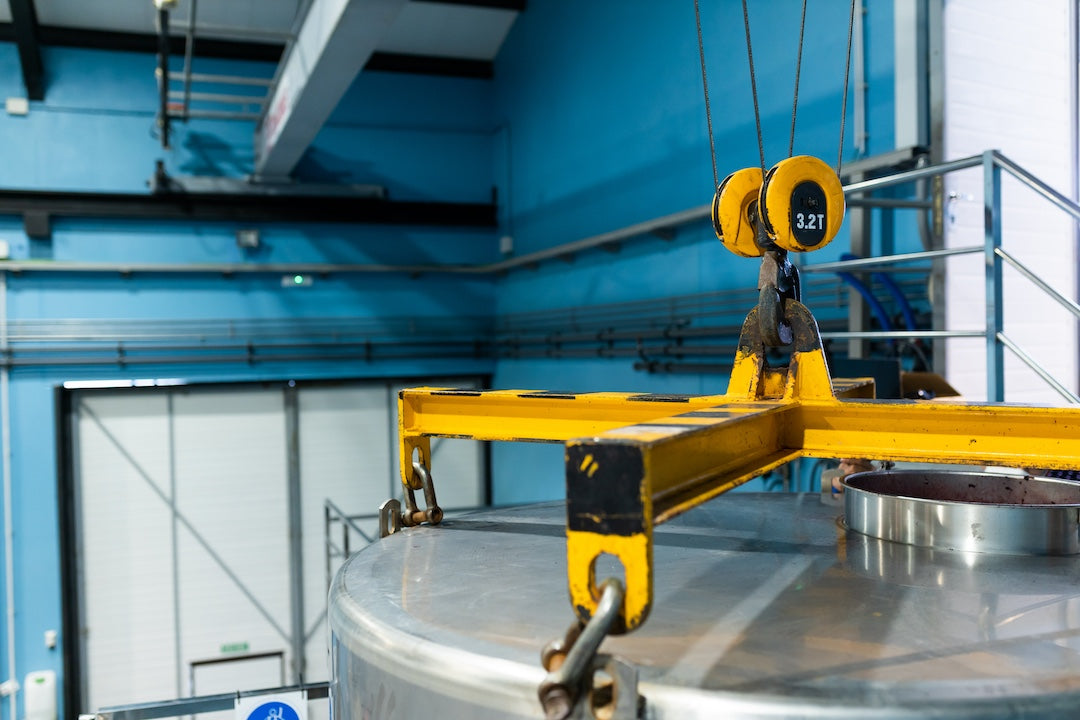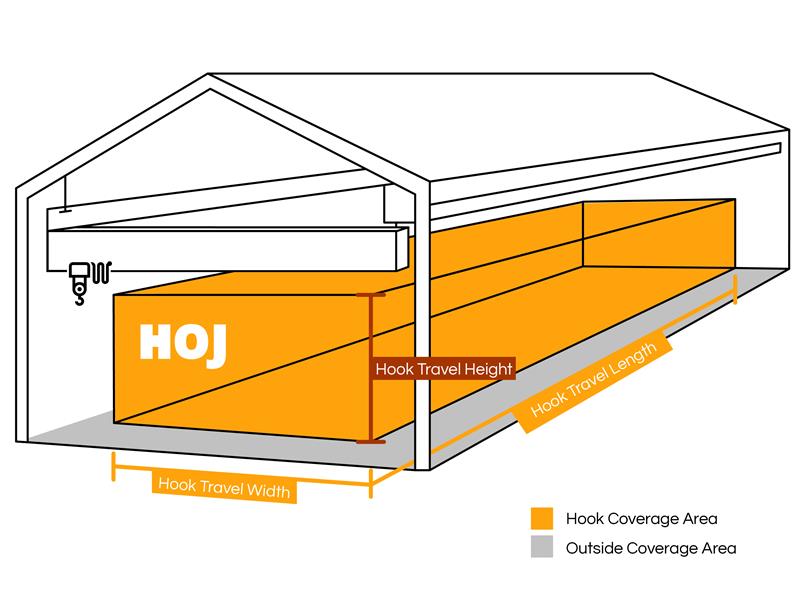Your Cart is Empty

Heads Up: Best Practices for Operating Overhead Cranes and Hoists
In the delicate world of material handling, the operation of overhead cranes and hoists stands out as a critical task that demands unwavering attention to safety. These powerful machines, essential for lifting and moving heavy loads, can pose significant risks if not managed correctly. Ensuring the safety of operators and other personnel is not just a regulatory requirement—it's a moral imperative that can significantly impact productivity and operational success.
At Hoj Innovations, we understand the gravity of these challenges. Our commitment to safety is woven into every aspect of our business, from the design and manufacturing of our equipment to the comprehensive training programs we offer. As a leader in the warehouse technology and material handling industry, we continually embrace the latest technologies and innovations that enhance safety measures. Our goal is to equip our clients not just with tools for lifting, but with solutions that ensure every lift is safe, efficient, and reliable.
This dedication to safety is more than a business practice; it's a promise to our customers that we stand beside them in creating a safer, more productive workplace. In the following sections, we'll explore the best practices for operating overhead cranes and hoists, emphasizing the importance of safety checks, proper procedures, and the role of cutting-edge technology in mitigating risks.

Understanding Overhead Cranes and Hoists
Overhead cranes and hoists are indispensable tools in warehouses and industrial environments, where they perform the essential function of moving heavy and bulky loads across various distances and heights. These systems are designed to handle materials that are otherwise too challenging to transport manually, significantly enhancing efficiency and reducing the physical strain on workers.
The most common types of overhead cranes include bridge cranes and gantry cranes. Bridge cranes run on elevated tracks and are commonly used in manufacturing environments where heavy lifting is a routine requirement. Gantry cranes, distinguishable by their overhead steel structures that support the hoist, are versatile and can be used both indoors and outdoors.
Hoists, which do the work of lifting and lowering loads, come in two primary types: wire rope hoists and chain hoists. Wire rope hoists are suitable for lifting very heavy loads and offer smooth operation and durability, making them ideal for frequent use in heavy-duty applications. Chain hoists, on the other hand, are typically used for lighter loads and are prized for their portability and simplicity.
Each type of crane and hoist comes with its own set of safety considerations. For instance, bridge cranes require regular inspections to ensure that the track and bridge are not compromised by wear or structural deficiencies. Gantry cranes demand checks for stable mobility and ground conditions, especially when used outdoors. For hoists, the integrity of the wire rope or chain is critical and must be regularly assessed for signs of damage or wear. Ensuring these components are properly maintained and operated within their load limits is essential to prevent accidents and maintain a safe working environment.
Pre-Operational Safety Checks
The safety and efficiency of overhead cranes and hoists depend significantly on regular maintenance and rigorous pre-operational safety inspections. These checks are crucial not only for compliance with safety regulations but also for extending the life of the equipment and minimizing costly downtime due to unexpected breakdowns.
Before any operation, a thorough inspection should be conducted, focusing on several critical components. The checklist should include:
- Hooks: Check for any cracks, deformation, and wear.
- Wire Ropes: Inspect for fraying, kinking, or any signs of external or internal wear.
- Chains: Look for broken links, excessive wear, or corrosion.
- Brakes: Test for proper operation and adjust if necessary to ensure they are responsive and reliable.
Incorporating technology into these routine checks can greatly enhance the accuracy and efficiency of inspections. For example, digital inspection tools and software can be used to track the condition of each component over time, providing alerts for when parts need maintenance or replacement based on usage patterns and historical data. Such technology not only ensures that no critical inspection checks are overlooked but also helps in maintaining a detailed maintenance record that can be invaluable during audits and can help in troubleshooting issues. By leveraging these technological solutions, facilities can ensure their equipment remains in optimal condition, thereby safeguarding their operations and their workforce.
Safe Operating Procedures

Adhering to safe operating procedures is crucial for preventing accidents and ensuring the longevity of overhead cranes and hoists. Implementing best practices starts with comprehensive training and clear guidelines that cover every aspect of operation.
Best Practices for Safe Operation:
- Load Limits: Always adhere to the specified load limits of cranes and hoists. Overloading can lead to equipment failure, resulting in potentially hazardous situations. Operators should be trained to understand load capacities and the risks associated with exceeding them.
- Control Labeling: Clear labeling on all control mechanisms is essential. This includes emergency stop buttons, speed controls, and directional controls. Operators must be familiar with these labels to prevent misuse and ensure quick response times in case of an emergency.
- Emergency Procedures: Effective emergency response procedures should be established and communicated to all personnel. This includes training on how to react if a load becomes unstable, power fails, or other operational issues arise. Regular drills can help reinforce these procedures and ensure they are second nature to the team.
Hoj Innovations' Role in Enhancing Operational Safety:
- Training Programs: Hoj Innovations provides tailored training programs that cover operational safety, emergency response, and routine maintenance. These programs are designed to ensure that all operators are well-versed in both theoretical and practical aspects of crane and hoist operation.
- Technological Enhancements: Leveraging advanced technologies, Hoj Innovations offers solutions like automated overload sensors, real-time monitoring systems, and predictive maintenance tools. These technologies not only prevent accidents by providing critical information at the right time but also enhance the overall safety culture within facilities.
By integrating these safe operating procedures with the latest safety technologies, Hoj Innovations ensures that clients not only meet but exceed safety standards, fostering a safe and efficient working environment.
Common Hazards and How to Avoid Them
Operating overhead cranes and hoists involves several inherent risks that, if not properly managed, can lead to accidents and injuries. Awareness and prevention are key components of a robust safety program.
Potential Risks and Hazards:
- Load Dropping: This can occur due to overloading, mechanical failure, or improper rigging. Such incidents pose serious safety threats to personnel and can damage the facility.
- Load Swinging: Swinging loads can result from sudden stops, improper handling, or external factors like wind. This can lead to collisions with other objects or personnel.
- Electrical Hazards: Since many cranes operate electrically, there is a risk of electrocution or electrical fires, especially if cranes are operated near power lines or if the equipment's electrical systems are not properly maintained.
Tips and Strategies to Mitigate Risks:
- Regular Maintenance: Conduct frequent inspections and maintenance to ensure all mechanical and electrical components are in good working condition.
- Proper Training: Ensure all operators are trained on the correct operation procedures, including load balancing, proper acceleration and deceleration, and emergency stop maneuvers.
- Use of Safety Equipment: Implement the use of limit switches, load sensors, and anti-collision devices to automate safety wherever possible.
Real-Life Scenarios:
- Case Study 1: At a construction site, a crane operator detected a small fault in the crane's hoist through routine diagnostics, a feature provided by Hoj Innovations. Immediate action was taken to repair the fault before it led to a potential load drop, demonstrating the value of preventive maintenance.
- Case Study 2: In a warehouse, an automated overload alert system developed by Hoj Innovations warned an operator of an imminent overload condition. The load was reduced according to protocol, preventing what could have been a catastrophic drop.
These examples underscore the importance of a proactive approach to safety and the critical role of advanced technology in mitigating risks associated with overhead cranes and hoists. By adhering to stringent safety protocols and embracing technological advancements, facilities can significantly enhance their safety profile.

Role of Technology in Enhancing Safety
Technology plays a pivotal role in enhancing the safety of overhead crane operations. By integrating advanced systems and devices, operators can achieve higher levels of precision and control, significantly reducing the likelihood of accidents.
Current Technological Advancements by Hoj Innovations:
- Load Monitoring Systems: These systems provide real-time feedback on the weight and distribution of the load, ensuring it remains within safe operational limits to prevent overloading and potential collapse.
- Automatic Shutdown Features: In critical situations, such as detecting a mechanical fault or operational error, these features automatically halt crane operations to prevent accidents. This immediate response is crucial in managing emergencies effectively.
The Future of Crane Safety:
- Predictive Maintenance Tools: Leveraging data analytics and machine learning, predictive maintenance can forecast potential equipment failures before they occur. This proactive approach not only ensures continuous safety but also optimizes operational efficiency.
- Augmented Reality (AR) and Virtual Reality (VR) Training: These technologies can simulate various scenarios for training purposes, allowing operators to gain experience in a controlled and safe environment. This hands-on training can dramatically enhance their ability to respond to real-world situations without the associated risks.
- Smart Wearables: Integrating smart wearables with crane operation systems can enhance operator awareness and safety. For example, wearables could alert operators to potential hazards or monitor their health to ensure they are in optimal condition for operating heavy machinery.
Implementation with Hoj Innovations:
At Hoj Innovations, embracing these technologies means not only implementing existing solutions but also continuously researching and developing new ones. Our commitment to innovation ensures that our clients are equipped with the most advanced tools to maintain a safe and efficient workplace. As we look to the future, our focus remains on developing smarter, more intuitive systems that further integrate safety into every aspect of crane operation.

Creating a Culture of Safety
Creating a culture of safety within the workplace is vital to ensure not only the protection of employees but also the efficiency and longevity of operations. At Hoj Innovations, fostering a safety-first culture is a fundamental principle that permeates all aspects of our operations.
Importance of Safety Training and Awareness:
- Comprehensive safety training programs are crucial for equipping employees with the knowledge and skills they need to operate safely. Regular training updates and refreshers are necessary to keep safety front and center.
- Awareness campaigns can help keep safety in the minds of employees daily. These might include posters, regular meetings, and updates on safety metrics.
Fostering a Safety-First Culture:
- Leadership Engagement: Leaders at all levels should demonstrate a commitment to safety by being actively involved in safety initiatives and by setting examples in following safety protocols.
- Employee Involvement: Engaging operators and maintenance teams in safety discussions and decision-making processes empowers them and reinforces the importance of their role in safety.
- Recognition and Rewards: Implementing a system to recognize and reward safe behavior can motivate employees to adhere to safety practices and contribute to a culture of safety.
Hoj Innovations’ Initiatives and Partnerships:
- Ongoing Initiatives: Hoj Innovations regularly updates its safety protocols and training programs based on the latest industry standards and technological advancements. This continuous improvement approach ensures that our safety practices are always at the cutting edge.
- Partnerships: Collaborating with industry leaders and safety organizations to develop new safety protocols and tools. These partnerships help us to leverage external expertise and innovations, which can then be integrated into our training and operational procedures.
By embedding these principles into every layer of your organization, you can ensure that safety is more than just a policy — it is a core value that guides your operations and your industry leadership. This commitment not only enhances the safety of your operations but also builds trust with your clients and within your teams.








